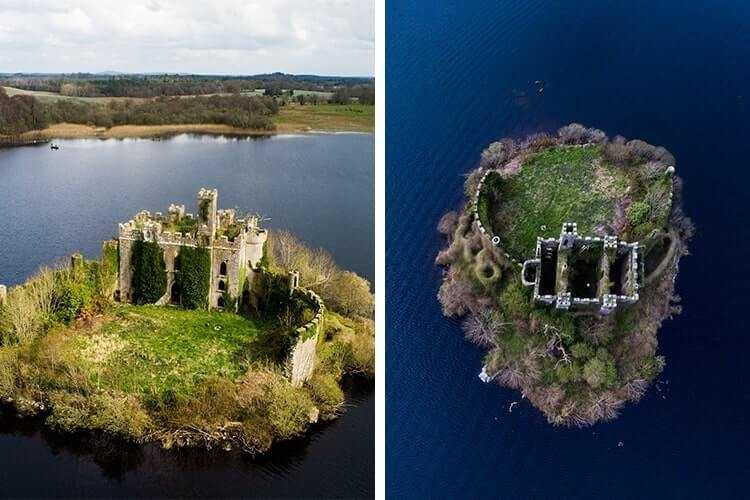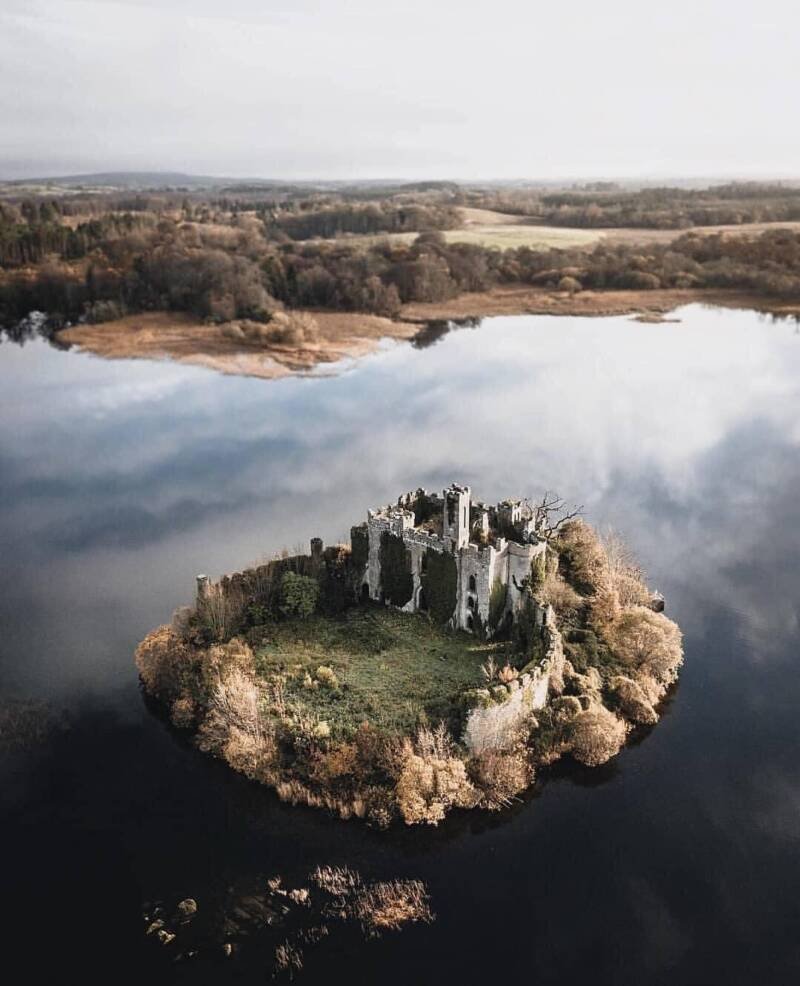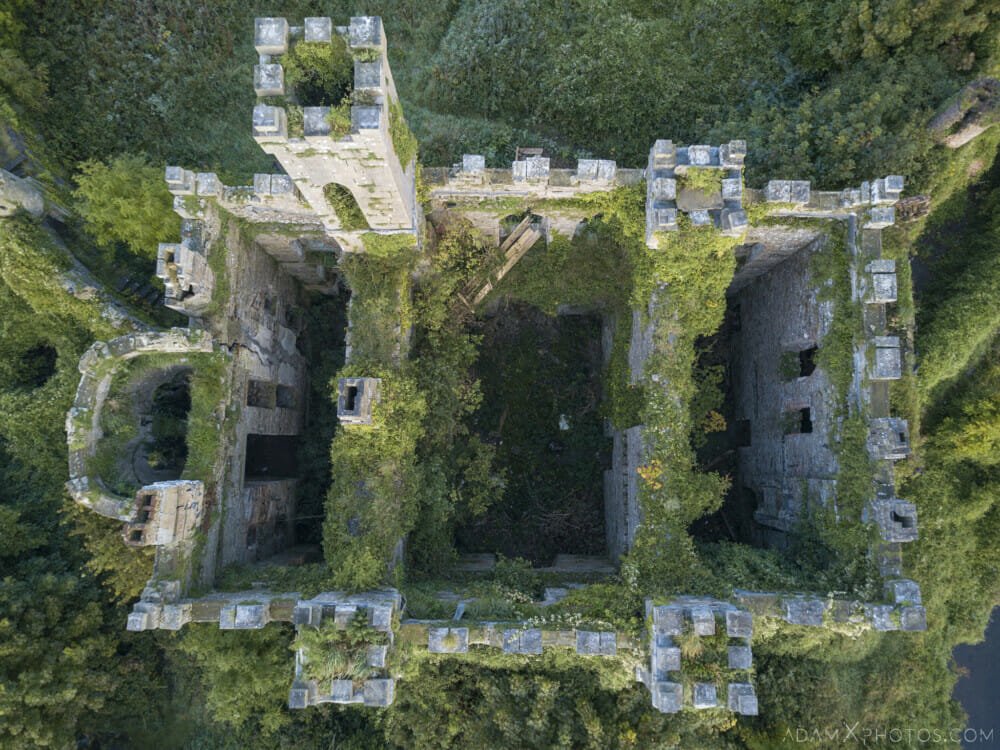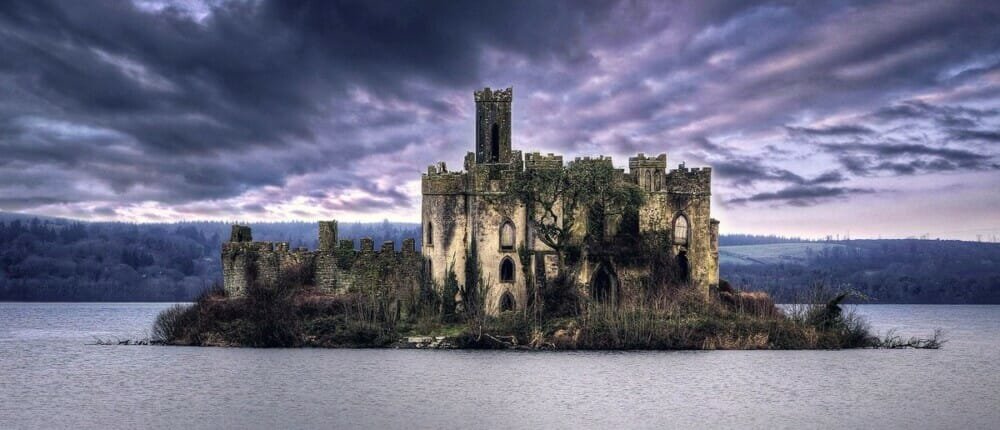In the middle of Lough Key in Ireland, an island castle stands abandoned and in ruins; the mystic surrounding is nearly as fascinating as its history.
Imagine the perfect setting for a fairy tale: on a shimmering, deep blue lake, a lonely island stands the test of time; in it, rising above the fog, are the ruins of a once majestic castle, turrets, and towers slowly being overtaken by ivy, walls crumbling, but still magical. This is a picture visitors can see in real life, south of Boyle in the Republic of Ireland. This place is Castle Island, one of the dozen of small islands that dot the vast scenic forests of Lough Key, where McDermott’s Castle stands the test of time. Destroyed, reconstructed, and abandoned many times over, this fairy tale castle has a suiting exciting background; witness to nearly a thousand years of Irish history, McDermotts’s Castle Island has been home to several generations of rulers and dynasties, the stage of battles, celebrations, conquests, and doomed love stories.
The History Behind McDermott’s Castle
The turrets and crumbling castle walls that are seen today, overtaken by nature and ivy, have an earlier past than this castle's imposing look might indicate: in the 19th century, Welsh architect John Nash (who projected Buckingham Palace) acquired Castle Island then abandoned for over three centuries, and built himself a folly castle. However, the history of the island is much older, dating back to the early Middle Ages, when Gaelic kings ruled over Ireland and when Castle Island was home and stronghold of kings.
The Medieval Kingdom Of Moylurg
In the medieval age, Gaelic Ireland was divided into many kingdoms, sometimes brought together by one High King. One of these kingdoms, in the region of modern County Roscommon, was the Moylurg (Magh Luirg) Kingdom, which for five centuries was ruled by the McDermott (Mac Diarmata) Clan.
According to the Annals of Loch Cè, one of the most important documents of medieval Ireland, Castle Island, then known as “the Rock,” was the seat of the McDermotts at the heart of Lough Key (Loch Cé in Irish). The Annals covered the events of Connacht and Moylurg from 1014 to 1590, chronicling McDermott’s castle history through the centuries.
King Diarmait, who gave the McDermott Clan its name (an earlier form of McDermott is mac Diarmata), died on the Rock in 1159 after ruling for 35 years.
In 1184 or 1887, the castle was struck by lightning and was destroyed in a terrible fire.
1235, the Rock came under siege by Richard Mór de Burgh during the Conquest of Connacht. Using a combination of catapults and fire, king Cormac McDermott had to surrender, and the McDermott Clan was forced to abandon the castle for a decade.
In a later letter by king Einigh McDermott, it is detailed the story of the Hag of Lough Key, a woman who visited the McDermott Castle during king Cormac McDermott’s rule and refused to leave for a whole year.
In the last 300 years of McDermott’s rule of Moylurg, the Rock was under constant turbulence, as succession disputes, attacks, and conflicts with the sometimes ally, sometimes enemy kingdom of Connacht painted Castle Island. Countless McDermott kings lived, ruled, and died at the castle on the Rock.
The McDermott Clan was permanently forced out of the Rock in the 1580s by Anglo-Norman invaders. The island would remain abandoned for centuries, pieces of the castles built and rebuilt through all the centuries of Moylurg left to rot.
The Poems Of McDermott Castle
McDermott’s Castle's grip on people’s imagination is not a new development. The Rock is the stage where the tragic Legend of Una Bhàn takes place - the story of the beautiful daughter of a McDermott king who fell in love with Tomás Láidir, whom her father disapproved of. After she fell into melancholy, the king sent word for Tomás Láidir to come to Una, but it was too late, and Una Bhàn died of a broken heart, buried on neighboring Trinity Island.
In the late 1500s, poet Eochaidh Ó hÉoghusa wrote a piece lamenting the Rock’s abandonment and the castle ruin.
19th-Century Whimsical Mansion
After being empty and abandoned for three centuries, the Rock was purchased by architect John Nash in the early 19th century. John Nash built a whimsical folly mansion in a medieval nostalgic style. The castle was used as a summer house to throw lavish parties atop the ruins of the true medieval fortresses.
Archeologists uncovered many base structures and luxurious artifacts from excavations on the island in 2018. The island is the site of remains from distinct centuries, the oldest of them being the enclosure wall that surrounds the island; it is the largest remain of the medieval strongholds and predates even the earliest findings of the McDermott’s castles.
Can You Visit McDermott’s Castle?
Castle Island is located in Lough Key, inside the area of Lough Key Forest Park. It is one of 30 islands dotting the Lough, many of which contain Moylurg Kingdom’s structures also, such as churches and important monasteries.
Outside of periodical control of ivy and low-level maintenance, Castle Island remains empty and mostly abandoned, its castle ruins attracting visitors for their whimsical and stunning look. Lough Key Forest Park offers boat tours that can take visitors to the island, taking in the sight. Boating and kayaking are popular activities in Lough Key, where Castle Island can be accessed. It's not likely a visitor will spend the night at this castle, but it is a wonderfully unique location to visit.
More To Do In Lough Key Forest Park
The Lough Key Forest Park is a wide expanse of scenic forests and spectacular Irish trails surrounding Lough Key, natural beauty steeped in the history of the Moylurg Kingdom and ancient Ireland. After taking in the stunning sight that is McDermott’s Castle Island, visitors can explore some of the other islands, including Trinity Island, where it is said Una Bhàn is buried.
The Park offers the Rockingham Remembered Tour, which goes through the history of the Loch - including another McDermott residence, where Moylurg Towers stands today -and a wide array of fun activities, from immersive puzzle games, camping, boating, and trekking.










